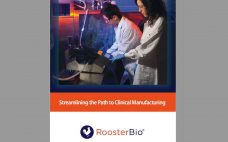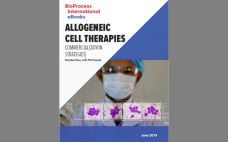It is an exciting time to be involved in the cell and gene therapy industry. We have come to a tipping point where we have shown that the science works. Now we need to industrialize and standardize it, so we can get these life-saving therapies to more patients. As an industry, we can learn from all the experience in the biologics space. With monoclonal antibodies (MAbs), we have transitioned from a manual process to a more standardized and automated set-up.…
Cell/Gene Therapies
Production of Transient Lentiviral Vectors in HEK 293T Cells: Cultivation on Fibra-Cel Disks in a Single-Use, Packed-Bed, Stirred-Tank Bioreactor
Although demand for lentiviral vectors (LVs) for cell and gene therapy is increasing, the standard two-dimensional culture systems used to produce LVs present significant disadvantages. Current bottlenecks in LV production are caused mainly by such disadvantages. Switching to use of bioreactors can eliminate those problems because bioreactors offer the benefits of process automation, tight regulation of production conditions, and reduced labor input. The study reported herein was carried out by the group of David Parsons at the University of Adelaide.…
Streamlining the Path to Clinical Manufacturing
Careful consideration of lot size is crucial for multiyear success of a cell therapy business. RoosterBio’s product design and acceleration business works with the company’s customers to help make plans that are appropriate for their stages of product and clinical development. We use the following major considerations in creating a sound multiyear strategy with intermediate milestones: Understand what the future looks like and work backward Use reasonable to conservative assumptions to estimate a range of needs Invest in the right…
eBook: Autologous Cell Therapies: Commercialization Strategies
Autologous cell therapies are derived from a patient’s own stem cells, typically collected from bone marrow. Those cells are then cultured, expanded, and reinfused back into the patient. Unlike allogeneic cell therapies, this process is repeated for each dose and for one patient. The one-to-one process carries several challenges to commercialization, including high development costs, the need to control the risks of manual processing, and compliance with strict timelines. This eBook presents two perspectives on addressing these challenges. The first…
Toward Standardized Sample Collections: UK Government Seeks to Expand Cell and Gene Therapy Use
The SAMPLE program — a Standard Approach to ATMP Tissue collection — is intended to help build capacity for the UK National Health System (NHS) to expand the use of next-generation cell and gene therapies for both cancer and noncancer illnesses. Now it has been given the green light by Innovate UK (IUK), the United Kingdom’s technology strategy agency. An award through the Industrial Strategy Challenge Fund is supporting the program for standardizing how cell and gene samples are collected…
Immunotherapy: Taking Aim at Solid Cancers
As cell and gene therapies arrive on the market, all eyes have focused on autologous chimeric antigen receptor (CAR) T – cell therapies. At the 2019 Phacilitate Leaders World and Stem Cell Summit in Miami, FL, delegates looked at where the biopharmaceutical industry is going in the cellular immunotherapy space. Whether for off-the-shelf CAR T-cell products, personalized cancer vaccines, or modified natural killer (NK) cells derived from human induced pluripotent stem cells (iPSCs) — cell and gene therapy development is…
Supply Chain Solutions for Cell and Gene Therapy Companies
Stakeholders across the supply chain stress that quality of starting material will be key to the success of cell and gene therapies. This is a topic that has created issues in the past, is puzzling the industry presently, and is likely to cause more problems going forward. This topic was front and center at the 2019 Phacilitate Leaders World and World Stem Cell Summit in Miami FL, with presentations focusing on supply chain solutions to address these complex challenges; cell…
Automation in Cell and Gene Therapy Development
The US approvals of chimeric antigen receptor (CAR) T-Cell therapies Kymriah (tisagenlecleucel) and Yescarta (axicabtagene ciloleucel) and gene therapy Luxturna (voretigene neparvovec) in 2017 heralded a “new frontier of medicine.” But with great innovation comes great costs and criticism (such as the Kymriah’s US$475,000 price tag). Many companies argue that these one-off therapies represent good value for patients and payers compared with traditional treatments, however, no matter your perspective, the COGs picture for cell and gene therapies isn’t good and…
Manufacturing of Cell and Gene Therapies
The peak of demand for curative cell and gene therapies will be unlike that of traditional drugs and thus could cause forecasting and overcapacity issues going forward. Predicting the future is always difficult, and poor decisions can be costly and highly damaging for a company. At the 2019 Phacilitate Leaders World and Stem Cell Summit in Miami, FL, several presentations and conversations focused on the forecasting dilemma and how manufacturing needs innovation, just to name two. This eBook details these…
eBook: Allogeneic Cell Therapies Commercialization Strategies
Manufacturers of allogeneic cell therapies face development and commercialization challenges unlike those of traditional cell therapies. In a discussion with Phil Vanek of GE Healthcare, we outline several of the key challenges of processing these products and bringing them to market. Approaches for reducing development costs and lowering pricing are highlighted, and a separate analysis presents three pricing models specific for allogeneic “off the shelf” cell products.










